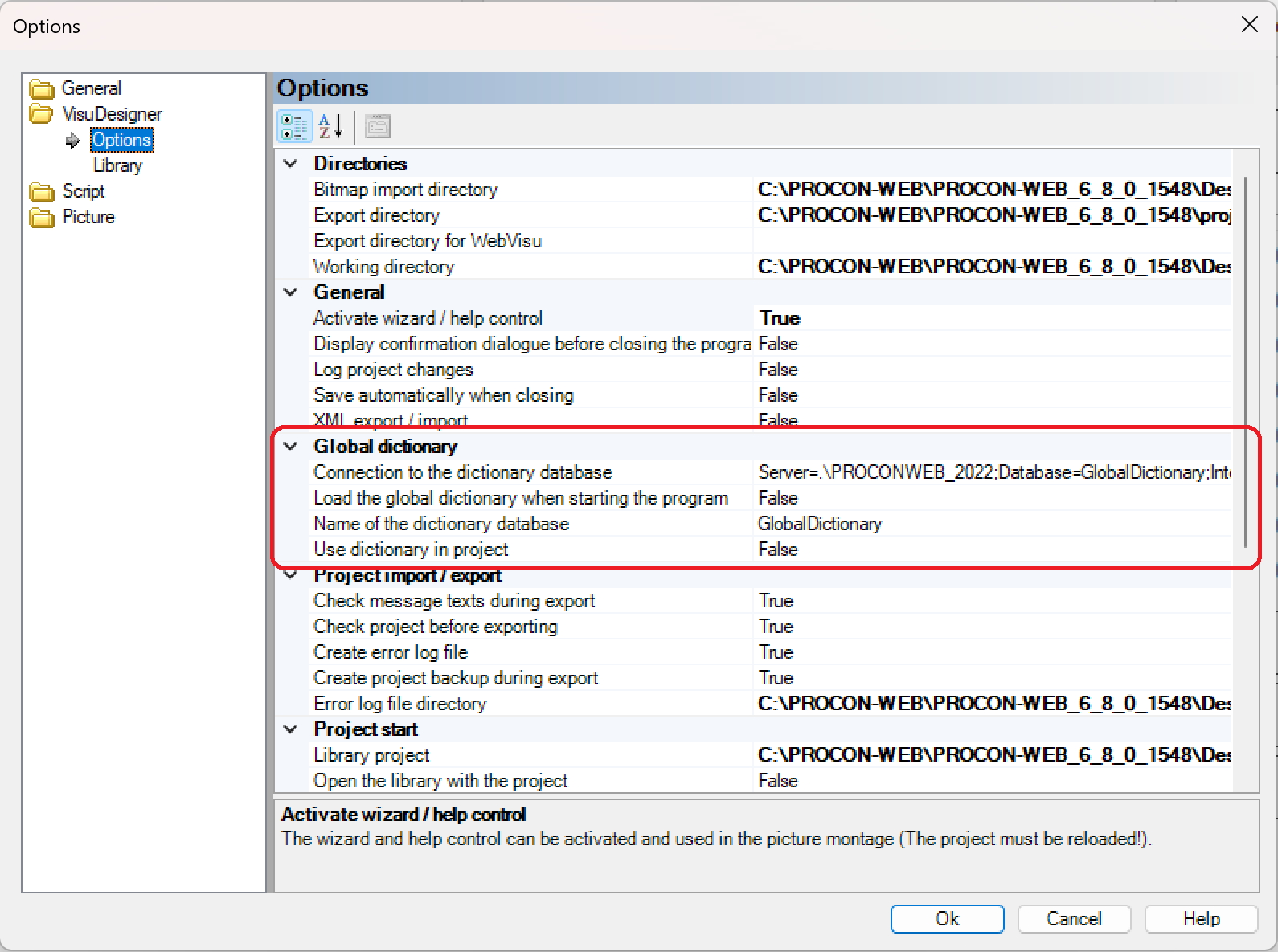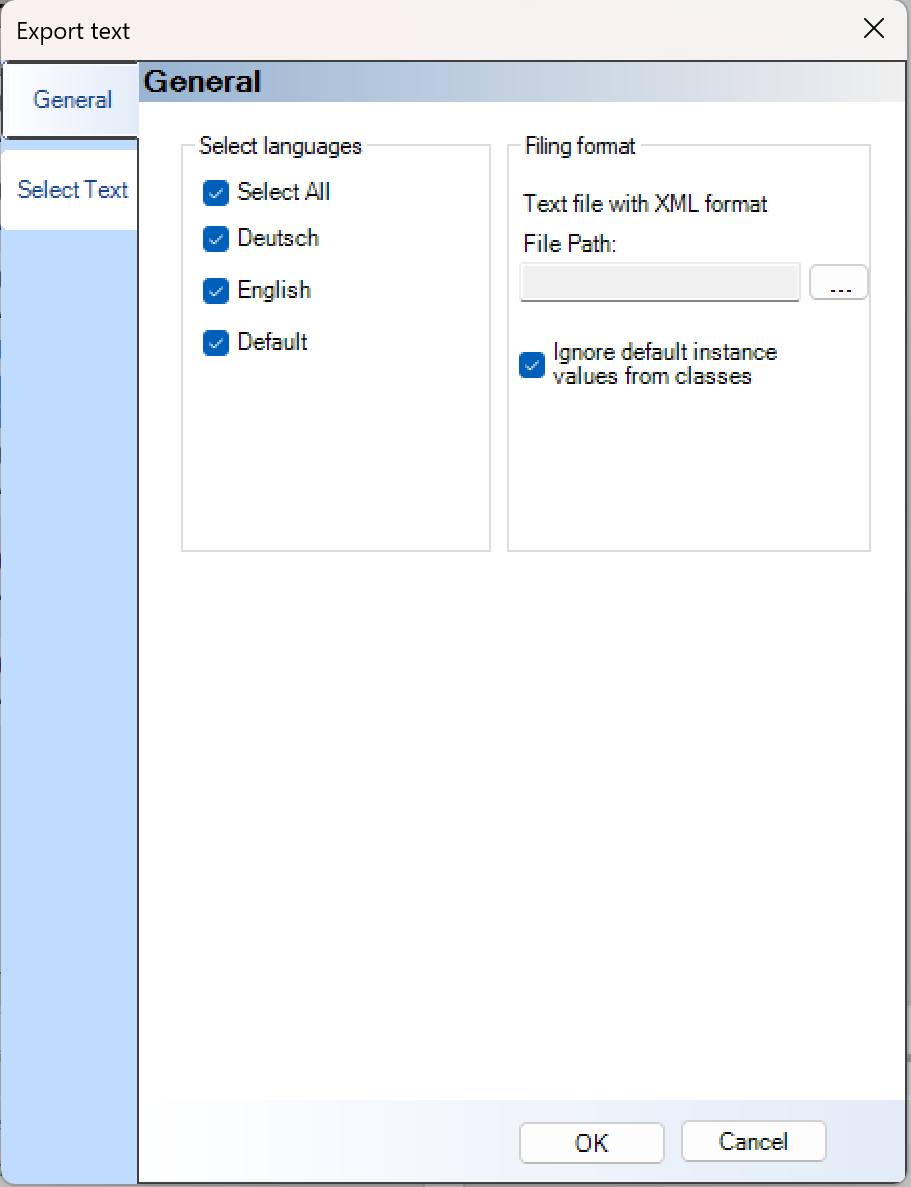Dictionary¶
General¶
A distinction must be made between the local and the global dictionary. A connection to the SQL server is required to use a global dictionary. With the local dictionary, the texts are managed directly in the designer.
Configuration global dictionary¶
The global dictionary is deactivated by default. To activate this, you have to change the configuration entry to “True” in the designer options. Attention: This change has a global effect! The entry can be found under:Options-> Designer-> Options-> General-> Load global dictionary when starting Designer.

In addition, the name of the global dictionary and the connection to the SQL server can be changed if necessary. You can also specify here whether a dictionary should be used in the project, i.e., whether a local one should be created.
Local dictionary¶
In the project tree of the PROCON-WEB Designer, texts for display (e.g. on a button) are managed in a local dictionary. This can be found in the project tree under Project.

The texts that have already been entered are displayed in table form. An entry (item) contains the name, an ID, a description, and the text itself. In the following columns all languages available in the project are displayed. The active languages are displayed first.

Text export and import¶
As with other texts, for example messages, the entries in the dictionary can also be exported for processing, for example in Excel, and then imported. It is important here that the structure of the XML file is not changed. In particular, the arrangement of the columns and their headings. Even if the changes are undone, the XML file cannot be imported again.

Note
To create a new entry, insert a new element in the file and leave the ID column empty. The file for the export / import is called “LocalDictionary.xml” resp. “GlobalDictionary.xml” by default.“.
If the text is changed, the following checks are carried out:
Scenario |
Exam |
|---|---|
Text item is available in the project |
Existing TextItem is used and assigned to the element |
Text item does not exist, is not used by another element |
The text of the TextItem is updated |
Text item does not exist, is used by another element |
TextItem is copied, the texts are updated and the new TextItem is assigned to the element |
With the global dictionary, it is possible to change the language or add a new one. The button to do so can be found in the ribbon tab. The process is the same as the one in the Designer in the work area multilingualism.
Use item¶
If the function “Use dictionary in project” is activated, the following options are available in the Designer at all places where a text item is used
If you enter the name of the item, a drop-down list with known elements is offered
When you start entering the test, there is also a drop-down list with the texts that are already in the dictionary
The selection dialog comes from the dictionary by calling the text fieldIf no known text or name is found when entering text, the designer creates a new text item.If the dictionary is not activated, there are no suggestions, and the text input is completely new for each text field.
Synchronise¶
Texts can be transferred from the global to the local dictionary or existing ones can be updated using the “Synchronise” button. The texts from the global dictionary are displayed in the dialog. If the button Synchronise is deactivated, no global dictionary has been activated.
Editing entries¶

It is possible to delete entries from the table. To do this, one or more lines must be marked. The entry can then be deleted either using the “Del” key or the context menu (“Delete”). It is also possible to use the context menu to display the texts that are no longer used. If texts exist more than once, they can be merged, and the duplicate ones automatically deleted
Configuration SQL-Server¶
After activating the global dictionary and editing the SQL-connection in the options, you must activate the TCP/IP-protocol in the SQL Server Configuration Manager.

If the SQL Server Browser isn´t yet installed as a service, you have to do this via the installer as a component. This service has to be active mandatorily. Additionally, the application itself and the TCP-Port 1433 and UDP-Port 1434 as an inbound rule have to be approved in the firewall.